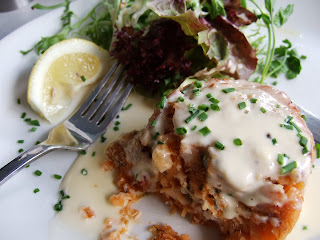
I've been editing a new bumper edition of my
Beyond Baked Beans student cookbooks recently (of which more later) and once again wondered where to place risotto. Is it an everyday recipe or a special occasion one?
What makes most people treat it as special occasion eating is that it needs pretty much full-on attention. Not that that's problematic - all you need is a glass of wine and someone else to chat to while you're making it but it creates the impression it's difficult. It truly isn't - the two things you need to remember are to cook the rice sufficiently (2-3 minutes) before you add any liquid and make sure the liquid you add is hot.
People also think it's expensive and it's true that risotto rice does cost more than ordinary long grain but not much more than basmatti these days. And if you use ingredients in season, as I've done here, it's not an expensive supper.
This is a version of a recipe I created for
Beyond Baked Beans Green (the veggie title in the series) which was originally dairy free. The other evening I made it for three of us with some fresh, young goats cheese but still no parmesan or butter. (The herbs do the job of the former.) It's lighter than a conventional risotto but perfect for showing off the new seasons' spring veg.
Spring vegetable, herb and goats cheese risotto
Serves 6 as a starter, 3 as a main course
A small bunch of asparagus
4 tbsp olive oil
1 medium-sized onion, peeled and finely chopped
250g risotto rice (e.g. arborio or carnaroli)
A small (125ml) glass of dry white wine
1 litre hot vegetable stock made with 1 rounded tbsp Marigold bouillon powder or an organic vegetable stock cube
1/2 a fennel bulb, trimmed and finely sliced (optional)
125g podded fresh or frozen broad beans
100g podded fresh or frozen peas*
150g fresh young goats cheese
3 heaped tbsp chopped fresh dill or fennel fronds, or chervil or parsley plus a little tarragon if you have some
Salt, pepper and lemon juice to taste
Break the tips off the asparagus spears about one third of the way down the stalk and set aside. Cut off any woody bits at the lower end of the stalk and chop the rest into small pieces. Heat 3 tbsp of the olive oil in a medium-sized saucepan or sauté pan and add the chopped onion. Stir and cook over a moderate heat for about 3 minutes then tip in the rice and stir. Let it cook for about 2 minutes without colouring, stirring occasionally so it doesn’t catch on the pan. Meanwhile heat the stock in another saucepan till it’s almost boiling and leave on a low heat. Pour the wine into the rice - it will sizzle and evaporate almost immediately. Add the chopped asparagus stalks and fennel, if using then start to add the stock bit by bit, about half a mugful at a time, stirring the risotto in between and cooking it until the liquid has almost been absorbed. Then add the next lot of stock and repeat until all the stock is used up and the rice is creamy but still has a little ‘bite’ to it (i.e. you don’t want it soft and mushy). This will take about 20 minutes. While you’re stirring away lightly cook the broad beans, peas and asparagus tips for about 3 minutes in the hot stock then scoop them out and set them aside on a plate or a saucer. Add the broad beans* and peas to the risotto a few minutes before adding the last of the liquid. Once the risotto is cooked stir in the goats' cheese and let it melt then stir in the herbs and season with salt, pepper and a good squeeze of lemon juice (about 2-3 tsp). Gently reheat the asparagus tips in the remaining oil. Serve the risotto in small bowls with one or two asparagus tips on top.
* If you want it to look especially beautiful you can take the skins off the broad beans after you've cooked them but at this time of year I wouldn't worry
 Having been reading a lot recently about how incredibly good turmeric is for you I’ve been devising ways of upping the quantity I use. It turned out particularly well with this super-easy (and frugal) chickpea curry
Having been reading a lot recently about how incredibly good turmeric is for you I’ve been devising ways of upping the quantity I use. It turned out particularly well with this super-easy (and frugal) chickpea curry






